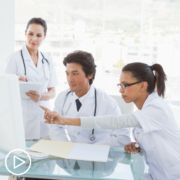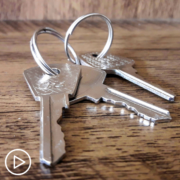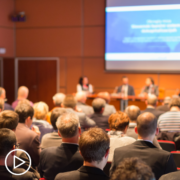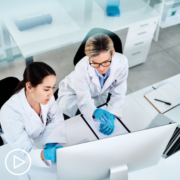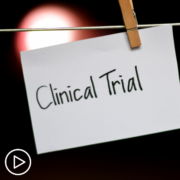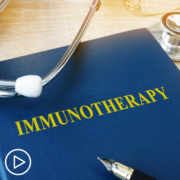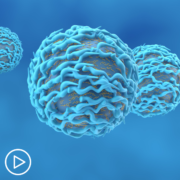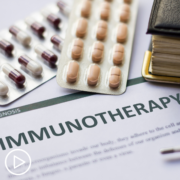Myeloma Research | CAR-T Cell & Bispecifics Study Updates from Patient Empowerment Network on Vimeo.
Myeloma expert Dr. Joshua Richter reviews the latest updates in myeloma research from the 2022 American Society of Clinical Oncology (ASCO) annual meeting and the European Hematology Association (EHA) Congress.
Dr. Joshua Richter is director of Multiple Myeloma at the Blavatnik Family – Chelsea Medical Center at Mount Sinai. He also serves as Assistant Professor of Medicine in The Tisch Cancer Institute, Division of Hematology and Medical Oncology. Learn more about Dr. Richter, here.
See More from Thrive Myeloma
Related Programs:
Transcript:
Katherine:
There were two major cancer meetings recently, ASCO and EHA. Are there research updates from those meetings that myeloma patients should know about?
Dr. Richter:
Absolutely. These are some of the biggest meetings that we have every year that attract all types of people, patients, caregivers, physicians, nurses, Pharma, even investors from all over the world. We’re coming off of the back-to-back American Society of Clinical Oncology and European Hematology Association meetings, and there were a couple of really important updates and data. One of them at ASCO actually had what we call a plenary session.
A plenary is the top type of session at any one of these congresses, and it was around something called the DETERMINATION trial which looked at something a lot of patients may be familiar with, the notion of getting VRd, Velcade, Revlimid, and dexamethasone, with or without getting a stem cell transplant as part of their initial treatment. Now, many years ago when our initial therapy was not so good, we showed that transplant was better than what was good 30 years ago.
But, we have better treatments now. So, do we still need high-dose chemotherapy and stem cell transplant?
And what was really interesting about this data set is that if you do get a transplant upfront, you do seem to have a longer PFS, progression-free survival, meaning you stay in remission longer if you get your transplant as part of your initial therapy. However, there was no difference in overall survival, meaning how long you actually lived. And this may not make a lot of sense at first, but think about patient one who stays in remission longer, but because now their disease is a little more refractory, the subsequent therapies don’t work as well as compared to the person who doesn’t get the transplant upfront.
And then those latter therapies work a little better, and when you add them all up, they come out about the same. So, I think one of the things that comes out of this is, “Do I need the transplant?” No, you don’t need the transplant as part of your initial therapy.
We’re still trying to figure out who really needs it and who doesn’t, but you can always never do it or save it for a later time. So, that was really one of the big things that came out of the ASCO meeting.
Katherine:
What about EHA?
Dr. Richter:
So, EHA had a lot of updates both in terms of CAR T-cell therapies and bispecific antibodies, and bispecific antibodies are near and dear to my heart. They’re my big passion in myeloma, and I had the honor of presenting updated data on the Regeneron 5458 bispecific antibody at EHA.
This is a BCMA CD3 bispecific. So, many people may be familiar with monoclonal antibodies like daratumumab, which is just an antibody that gets injected and attacks the cancer.
Bispecifics are molecules that are injected that have two arms. One grabs onto the cancer cell; the other grabs onto your own immune cells that we call T cells and activates them to attack the cancer. Very interesting new therapy.
Very exciting, and very high response rates in people who have had tons and tons of treatment. So, in people that have seen almost everything in the highest dosing group of the study, 75 percent of people responded, which is very, very high.
But more notably, the big side effect we look out for called CRS or cytokine release syndrome, that’s where we activate your T cells and they get so activated they can cause other problems. That can be pretty high in some of our immune therapies, but in this drug, there’s only 38 percent, and all of this was relatively minor. It wasn’t the really big stuff.
So, the reason why this is so near and dear to my heart is that some of these therapies like CAR T have to be given in a major center that does transplants.
But bispecific antibodies, if put together the right way, can be given in your local hematologist’s, oncologist’s office. So, a lot of great potential long-term get everybody treated with these drugs. And then, one or two other little things that I thought were really huge, one was the combining of bispecific antibodies. Studies called the TRIM protocols combined two different bispecific antibodies, one called teclistamab, and one called told talquetamab. Each got combined with daratumumab.
So, not only are we already seeing just the bispecific by itself, we’re starting to combine it and seeing unbelievable response rates. That was updated at EHA, which was groundbreaking. And then in CAR Ts, two things really caught my mind. One was the CARTITUDE-2 data basically giving CAR Ts earlier on to patients had a 100 percent response rate. Can’t really do better than 100 percent. So, it’s not just about getting 100 percent of people in remission.
It’s keeping them there and curing them, and it starts by getting 100 percent of people to respond. So, really looking forward to see how this develops.
But one of the other things was another CAR T that’s coming out of China that targets two different things. It targets BCMA and CD19, both of which can be found on myeloma cells, although CD19 is actually on the myeloma stem cell. It’s a little kooky. But one of the big issues with CAR Ts is manufacturing time. Right now, it takes four to eight weeks to make them. But in this construct, they were able to make them, it took them between 22 and 36 hours. So, for many people, they were able to manufacture the CAR Ts, theoretically, for patients within one day.
So, if we can not only get this therapy to work but shrink the manufacturing from a month or two to a day or two, that would make this more accessible to more patients, get them to their treatment on time. So, the sky’s the limit with our immune options right now.
Katherine:
What makes you hopeful?
Dr. Richter:
So, we’ve had what we call Gestalt switches in myeloma. And what I mean by that is let’s rewind decades ago. We gave chemotherapy. Chemotherapy was designed to kill any cell that divides rapidly because that’s what cancer cells like to do.
It kills the good and the bad. It makes your hair fall out, throw up, horrible stuff. It doesn’t work too well. Then about 20 years ago, we started this switch to the novel therapies, Revlimid, thalidomide, Velcade, and then a decade later, daratumumab. And now, we’re having targeted agents which spend more time targeting the bad stuff, less time doing off-target stuff, really ramping things up.
We are at the precipice of a brand-new Gestalt switch in myeloma. The immune world. The immune therapies. And right now, T-cell redirection therapy is what we call it either with CAR-Ts, where we take your T cells out, engineer them, and put them back into your body all revved up, or we give you an off-the-shelf, bispecific that grabs onto your cancer and your T cell and, brace yourself, we even have trispecifics, which can engage your myeloma, another cell in your body, and yet another cell.
If you go on clinicaltrials.gov, which lists all the trials for everything, every disease, there are over 3,000 active trials in myeloma.
And what I tell people is when I first started and I sat across from a patient, I would say, “I’m really sorry. It’s not curable.” And now I say, “We are curing some people today by accident.” But over the next period of time, we’re going to do this deliberately and more frequently. And the goal is and always has been 100 percent of cure for 100 percent of patients, 100 percent of the time.
And, I kind of feel right now we’re almost like that 2001: A Space Odyssey when the obelisk lands. We have these immune therapies. We know they’re great. How do we combine them? How do we use them? How do we take all these great tools and turn it into a cure for everyone?”
And with so many great partners between advocacy groups and pharma and patients and cancer centers, we’re going to collaborate, and we’re going to start getting those answers in my lifetime, and I could not be more excited about that.
Katherine:
Oh, I bet. I bet.

